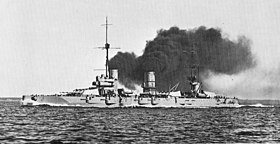Poltava (1911)
|
|
|
|---|---|
 Poltava |
|
| Overview | |
| Type | Battleship |
| Shipyard |
Admiralty Shipyard, St. Petersburg |
| Order | 1908 |
| Keel laying | June 15, 1909 |
| Launch | July 10, 1911 |
| Namesake | Poltava city |
| Commissioning | December 1914 |
| Technical specifications | |
| displacement |
|
| length |
Waterline: 179.8 m |
| width |
26.9 m |
| Draft |
8.3 m |
| crew |
1,125 men |
| drive |
|
| speed |
Max. 23.4 kn |
| Range |
4,000 nm at 16 kn |
| Armament |
12 × 305 mm-L / 52 -SK |
The Poltava was the last of four dreadnought liners of the Russian Gangut class . In addition to the Gangut, sister ships were the Petropavlovsk and the Sevastopol . The four were the first Russian dreadnoughts. Since Russian shipyards had little experience with the construction of modern capital ships, but the Duma only approved funds for construction at Russian shipyards, Italian, German ( Blohm & Voss ) and Scottish designs were requested. This ultimately led to a rather idiosyncratic design based on the Italian Dante Alighieri . The ships had an icebreaker bow and two of the four towers were amidships in front of and behind the second chimney. It took a long time to build the ships because Russia had difficulties producing enough steel in sufficient quantities.
The Poltava was laid down in St. Petersburg in 1909 , launched in July 1911 and completed in December 1914. During the First World War she served in the Baltic fleet of the Russian Navy . A major fire in 1922 damaged the ship so much that it was not repaired, but only cannibalized. In 1925 it was renamed Mikhail Frunze , but only used as a Hulk until it was scrapped in the 1950s.
Two of the four triplet towers were used in the reconstruction of the Maxim Gorki I coastal battery from 1954 .
literature
- Siegfried Breyer: Battleships and battle cruisers 1905–1970. JF Lehmanns Verlag, Munich 1970, ISBN 3-88199-474-2 .